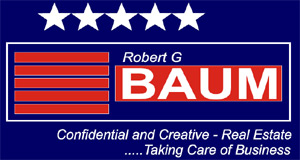-

- Robert G. Baum
Commericial Real Estate
79 St. James Street
Kingston, NY 12401
Lower Hudson Valley:
(845) 242-2100
Capital District, NY
& Berkshires:
(413) 209-0013 -

-
-
Selling Commercial Property
Selling a commercial property is much more complex proposition. Establishing a clear price strategy, understanding your potential buyers and marketing the property can be daunting tasks. Here are some tips to assist in selling your commercial property.
1. Establish a pricing strategy
Comparable properties.
Have Robert G. Baum Realty prepare a ‘comparable properties report,’ which will indicate the price that similar buildings have sold for, the date of sale and proximity to your building. This will give you an idea of how the local market is behaving. Taking a tour of competitive buildings will also provide you with more direct market knowledge for your property. It’s good to see what your competitors are offering. After studying your competition first-hand, you’ll have a better idea of how your building measures up.
Property valuation.
It can be difficult to find similar commercial properties for a true price comparison, so this is why commercial property is usually best valued according to its Net Operating Income (NOI). The capitalization rate of your property can be used as a way to compare your asset with others available on the market. The capitalization rate is the rate-of-return based on the expected income the property will generate (capitalization rate = yearly income / total value). For example, if you buy a property that will generate $260,000 per year and paid $2,000,000 for it, the capitalization rate is: 260,000/2,000,000 = 13%. As a general rule-of-thumb for commercial real estate, ±10% is considered a ‘good’ return on investment. However, that said – CAP rates also are determined and are affected by regional offerings and quality of the property. And, don’t forget the “all important” deferred maintenance issues which have a direct affect on selling price.
3. Understand investors points of interest
Investors will be interested in a particular set of selling points. Attracting the right buyer for your property will help it sell in a timely manner. Make sure that your information is up-to-date and accurate, as it will come up at the negotiating table! It’s much easier to negotiate a favorable contract if your information cannot be disputed.
Selling with vacancies versus no vacancy.
Investors who are interested in turnkey properties love 100% leased properties, especially when the tenants have established businesses with long-term lease contracts. However, there are other investors who are interested in opportunities to improve a building’s tenant mix and make improvements.
Current tenants.
A rent roll provides a list of all your the current tenants in your property, their contract expiration dates and lease rates. The more established businesses with long-term leases will be more highly valued than unknown companies with short-term contracts. If you are having difficulty selling a property, be sure to analyze the tenant mix. If a few of your tenants are weaker than others, you may want to make some changes.
Clean up and repairs.
Good first impressions can be crucial to receiving offers. Consider sprucing up your landscaping, cleaning vacant spaces and making repairs. You don’t need to wait until repairs are completed to place your property on the market. Descriptions and photos can be updated as your improvement projects progress.
Location highlights.
Location may not be the main focus for a commercial real estate investor, but it is the number one concern for potential tenants. Be honest with the property’s location highlights because something you perceive as undesirable may be a selling point to someone else. For example, while some tenants prefer a quiet setting, others thrive in high traffic areas. Note your building’s most recognizable cross streets, its proximity to highways, public transportation, or other area retailers and traffic generators. An investor wants to know what will attract potential tenants to a particular location. Offering information about current occupants and what types of tenants are most successful can be an important selling point.
3. Marketing your property
Potential investors need to be aware that your property is available before they can send offers. Utilize every marketing channel to reach out to potential buyers.
Online databases.
Large databases can help expose your property to thousands of commercial real estate agents and buyers. Your broker may want to integrate social media into your online advertising plan as well. The more people you can reach via the internet, the easier it will be to attract investors.
Sales packages and other printed materials.
An effective sales package (or offering memorandum) can be a valuable tool. Focus the content of your material on features which will appeal to buyers. A professional design will separate your property from the crowd. Including a well made sales presentation to your online databases and using them for mailers will get your property noticed.
Investors’ points-of-interest:
Remember the selling points that buyers care about the most: net operating income, cap rate, sales comps, tenant mix, vacancy rates, property highlights, location highlights and demographics.
Financial statements:
Including a pro forma income statement and rent roll will demonstrate the mix of tenants that the property attracts, and how much yearly income they can expect from the property.
High quality signage.
We will create large, readable and attractive signs to place on your property. Signs should be visible from the street, and display Contact information. Our “in-house” sign production facility can create signs from 18″ x 24″ to 100′ x 100′ banners to be placed on large buildings.
4. Appreciate details about different property types
An investor wants to know what businesses will be attracted to a particular property. The easier it is to find quality tenants, the easier it will be to get a return-on-investment.
Office:
While some businesses will prefer an affluent location with educated demographics, others will appreciate offices close to public transportation or lower income areas. Be clear about your location’s demographics and the traffic counts in the area because different highlights will appeal to different buyers.
Medical office:
The layout of a medical office is important to particular specialty areas. Neighboring practitioners such as nearby laboratory services and hospitals may also be important. Highlight neighboring providers in your marketing materials, since locations that are close to medical specialists, laboratories and hospitals are generally in greater demand.
Retail:
We emphasize the area’s demographics, traffic counts, accessibility and parking. Demographic information, including average income, ethnicity, average home prices and proximity to schools should be provided. Also, highlight neighboring traffic generators like super centers, grocers and banks. The busier the area, the better the location will look to buyers.
Industrial:
Draw attention to your industrial building’s proximity to highways, railways or shipping yards. Also, make sure to highlight the different zones and amenities your building has, such as docking areas, warehouses and office areas.
Multi-family:
Be honest about the condition of your duplex, triplex, quad or apartment complex because ’flipping‘ apartment buildings is as popular as purchasing turnkey complexes. Some buyers may prefer to do the construction improvement work while others won’t.
5. Find a commercial real estate agent!
It’s difficult to do all of these things alone. With all the complications of selling commercial property, consider Robert G. Baum Realty. When it comes to helping property owners sell their commercial real estate, we can provide guidance, property valuation, comparable sales reports, targeted marketing, demographic reports, traffic counts and contract negotiations. We can provide a full range of seller representation services to all clients. If you need help to find potential investors, assistance with your pricing strategy or finding the appropriate buyer for your building, we have the expertise.

